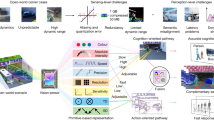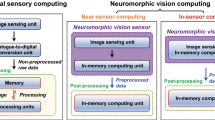Abstract
Electronic retina is a combination between in situ signal processing and image sensing on a same silicon chip. This smart image sensing, realizable in commoncmos technology, is a valuable technique in real-time vision systems. In order optimize the global performance of a vision machine where different levels of processing are needed, this technique can not be considered simply as an intelligent image sensor design problem. Because the local onsensor information processing in an electronic retina should be placed in a more general context including algorithms, architectures and applications. This paper tries to give an overview on the electronic retina based vision systems and especially on the roles that an electronic retina can play in real-time vision systems.
Résumé
Une rétine électronique est une combinaison entre le traitement de signal in situ et la capture d’image sur la même puce de silicium. Cette capture intelligente d’image, réalisable dans une technologiecmos standard, est une technique très utile dans des systèmes de vision en temps réel. Si l’on veut optimiser la performance globale et finale d’une machine de vision dans laquelle sont impliqués différents niveaux de traitements, cette technique ne peut être étudiée dans le seul cadre d’une conception d’un capteur d’image intelligent. Parce que les traitements locaux d’information sur la rétine électronique font partie intégrale d’une machine de vision complète. Par conséquent, la conception d’une rétine électronique doit être étudiée avec une approache algorithme-architecture-application orientée. Cet article essaie de donner une vision générale sur des systèmes de vision basés sur rétine électronique en insistant sur les rôles qu’une rétine électronique peut et doit y jouer.
Similar content being viewed by others
References
Hubel (D.), “Eye, Brain and Vision”,Scientific American Library, New York, 1988
Marr (D.), “Vision”,edited by Freeman, New York, 1982
Lyon (R. F.), “Optical mouse, an Architectural Methodology for Smart Digital Sensors”,Proc. of the Carnegie Mellon University Conference onvlsi Systems and Computation, Pittsburg, 1981
Fukushima (K.)et al., “An Electronic Model of the Retina”,Proc. of theieee,58, no 12, Dec, 1970, pp. 1950–1951.
Sivilotti (M.),Mahowald (M.A.),Mead (C.), “Real-time Visual · Computations Using Analogcmos Processing Arrays”, inConf. Advanced Research invlsi, 1987, pp. 295–312.
Moini (A.), “Vision Chips or Seeing Silicon”, http://www.eleceng.adelaide.au/Groups/GAAS/Bugeye/vision-chips/index.html
Forchheimer (R.)et al., “Mapp2200 — A second Generation Smart Optical Sensor”,Proc.spie, Image Processing and Interchange: Implementation and Systems,1659, pp. 2–11, 1992
Fossum (E.R.), “cmos Image Sensors: Electronic Camera-on-a-Chip”,ieee Trans. On Electron Devices,44, no 10, Oct. 1997, pp. 1689–1698
Renshaw (D.),Denyar (P.B.),Wang (G.),Lu (M.), “Asic vision”,Custom Integrated Circuits Conf., pp.731–734, 1990
Ni (Y.), « Problèmes et solutions de la sensitivité photoélectrique dans les rétines électroniques»,Colloqueread’97, Evry, 1997.
Bernard (T.M.),Garda (P.),Reichart (A.),Zavidovique (B.),Devos (F.), “Design of a Half-toning Integrated Circuit Based on Analog Quadratic Minimization by Non-linear Multistage Switched Capacitor Network”,Iscas’88, Helsinki, Finland, June 1988.
Bernard (T.), « Rétines Intelligentes Programmables: si nous parlions silicium pour voir... », Doctoral Disertation, Université Paris-Sud 1992.
Bernard (T.M.),Zavidovique (B.Y.),Devos (F.J.), “A Programmable Artificial Rtina”,ieeeJ. Solid State Circuits,28, no 7, pp. 789–798, July 1993.
Forchheimer (R.),Aström (A.), “Near Sensor Image Processing: A New Paradigm”,ieeeTrans. On Image Processing,3, no 6, 1994.
Garda (P.),Devos (F.),Zavidovique (B.), “Integrated Cellular Array Performing Neighboorhood Combinational Logic on Binary Pitcures”,Proc.esscirc’85, Toulouse, France, Sept. 1985.
Ferrari (F.),Nielsen (J.),Questa (P.),Sandini (G.), “Space variant imaging”Sensor Review,15. no 2, pp. 17–20, 1995
Iwai (H.),cmos Device Architecture and Technology for the 0.25 Micron to 0.025 µm Micron.
Pardo (F.),Scheffer (D.), “cmos Foveated Image Sensor: Signal Scaling and Small Geometry Effects”ieeeTrans. Electron Devices,44, no 10, 1997, pp. 1731–1737.
Agon (A.),Graf (H.G.),Serger (U.),Siggelkow (A.), “A High Dynamic Range Camera”Proc. ofPro-chip Workshop, Dec. 1993, Toulouse, pp. 53–62.
Delbrück (T.),Mead (C.), “Phototransduction by Continuous-Time, Adaptive, Logarithmic Photoreceptor Circuits” Tech. Rep., California Institute of Technology, Computation and Neural System Program,cns Memorandum 30, Pasadena, CA 91125, 1994.
Dierickx (B.)et al., “Random addressable active pixel image sensors”, to appear inProc. of Conference on Advanced Focal Plane Arrays and Electronic Cameras as part ofspieInternational Symposium on Advanced Imaging and Network Technology, Oct. 7–11, Berlin, Germany 1997.
Ni (Y.),Lavainne (F.),Devos (F.), “cmos compatible photoreceptor for high-contrast car vision” Intelligent Vehicle Highway Systems,spie’s International Symposium on Photonics for Industrial Applications, Oct.–Nov. 1994, Boston, pp. 246–252.
Scheffer (D.)et al., “Random Addressable 2048×2048 Active Image Sensor”ieee Trans. Electron Devices,44, no 10, pp. 1716–1720, Oct. 1997.
Seger (U.) et al., “Vision Assistance in Scenes with Extreme Contrast”ieee micro, pp. 50–56, Feb. 1993
Loose (M.), “A Self-Calibratingcmos Image Sensor with Logarithmic Response”, Ph. D thesis, Institut Für Hochenergiehysik, Universität Heidelberg, 1999.
Ni (Y.) et al., “Acmos Log Image Sensor with on-chipfpn Compensation”esscirc’2001, 18–20 Sept. 2001 Villach, Austria, pp. 128–132.
Ni (Y.),Devos (F.),Boujrad (M.),Guan (J.H.), “A Histogram Equalization based Adaptive Image Sensor for Real-Time Vision”,ieee J. of Solid State Circuits, pp. 1027–1036,32, no7, July 1997.
Carrier (G.F.),Pearson (C.E.), “Partial Differential Equations: Theory and Technique”Academic Press, NY, 1976.
Harris (J.),Koch (C.),Luo (J.),Wyatt (J.), “Resistive Fuses: Analog Hardware for Detecting Discontinuities in Early Vision” in Analogvlsi Implementation of Neural Systems,Mead (C.) andIsmail (M.), pp. 27–56,Kulwer Academics, 1989.
Horn (B.K.P.), “Parallel Networks for Machine Visio”, in Artificial Intelligence at MIT — expanding frontiers, edited by P. H. Winston,2,TheMit Press, 1990.
Kobayashi (H.),White (L.),Abidi (A.A.), “An Active Resistor Network for Gaussian Filtering of Images”,ieeeJ. Solid State Circuits,26, no5, pp. 738–748, May 1991.
Bernard (T.), « Convolueur imageur électronique », T. Bernard, Brevet français no 69-16552, 1989.
Knight (T.), “Design of An integrated optical sensor with on-chip preprocessing”, PhD Thesis,Mit, 1983.
Sage (J.P.), “Gaussian Convolution of Image Stored in a Charge Coupled Device”, Solid State Research, Quarterly Technical Research, from 1 august to 31 october 1983,Mit Lincoln Lab., pp. 53–59.
Andreou (A.G.),Boahen (K.A.),Pouliquen (P.O.),Pavasovic (A.),Jenkins (R.E.),Strohbehn (K.), “Current-mode subthresholdmos Circuits for analogvlsi neural Systems”,ieee Trans. On Neural Networks,2, no 2, pp. 205–213, 1991.
Sotak (G.E.),Boyer (K.L.), “The Laplacian of Gaussian Kernel: A Formal Analysis and Design Procedure for Fast, Accurate convolution and full-frame output”, Computer Vision, Graphics and Image Processing, pp. 147–189, 1989.
Blake (R.),Wilson (H.R.), “Neural models of stereoscopic vision”,tins,14, no 10, 1991, pp. 445–452.
Enkelmannet al., “An Experimental Investigation of Estimation Approaches for Optical Flow Fields”, in Motion Understanding — Robot and Humain Vision, edited by W.N. Martin & J.K. Aggrawal, Kluwer, 1988.
Marr (D.),Poggio (T.), “A Theory of humain stereo vision”,Proc. Roy. Soc. London,B204, pp. 301–328, 1979.
Marr (D.),Poggio (T.),Ullman (S.), “Bandpass channels, zero-crossings, and early visual information processing”,J. Opt. Soc. Am, 1979.
Ni (Y.),Zhu (Y.M.),Devos (F.),Arion (B.), “Yet Another Analog 2D Gaussian Convoluer”,Iscas93, Chicago, 3–6 May, 1993, pp. 192–5, vol. 1.
Ni (Y.),Skuras (I.),Arion (B.), “Towards a fully integrated analog 2D Marr-Hildreth filter”,Proc. of World Congress on Neural Networks 1993, Portland, juillet 1993, pp. 810–812.
Ni (Y.),Arion (B.),Devos (F.), “Investigation of an Analog Retina for real-time stereovision in automobile”,Intelligent Vehicule Symposium 94, Oct. 1994 Paris, pp. 320–325.
Arion (B.),Ni (Y.),Devos (F.), “An Analog Visual Feature Extraction Retina for real-time Stereovision”,essirc’95, 19–23 sept. 1995, Lille, France, pp. 246–249.
Ni (Y.)et al., “A 256×256-pixel Smartcmos Image Sensor for Line based Stereo Vision Applications”,ieee,J. of Solid State Circuits,35. no 7, July 2000, pp. 1055–1061.
Arion (B.),Ni (Y.),Devos (F.), “An Analog Retina based Stereoscopic Vision System for Automated Vehicule Guidance”,Cas’96, Roumanie, 1996.
Jones (W. D.), “Keeping cars from crashing”,ieeeSpectrum Sept. 2001, pp. 40–44.
Marr (D.)et al., “A Theory of edge detection”,Proc. R. Soc., London B207, 1980, pp. 237–248.
Author information
Authors and Affiliations
Rights and permissions
About this article
Cite this article
Ni, Y. Electronic retina based vision systems an adequation algorithm-architecture application approach. Ann. Télécommun. 59, 287–303 (2004). https://doi.org/10.1007/BF03179699
Received:
Accepted:
Issue Date:
DOI: https://doi.org/10.1007/BF03179699
Key words
- Computer vision
- Retina
- Signal processing
- Image sensor
- Integrated optoelectronic circuit
- Optical receiver
- Stereoscopy
- System architecture




